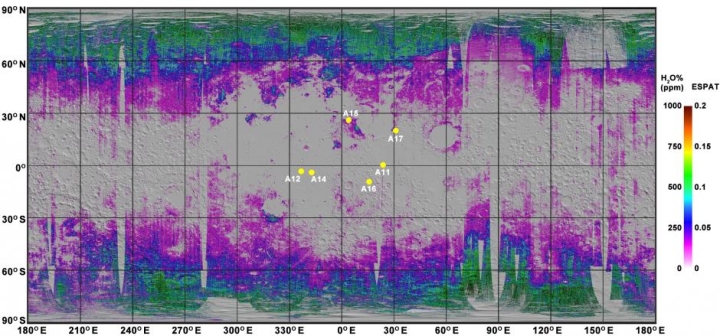First global map of the trace water on the Moon

Using data collected by an American instrument on India’s Chandrayaan-1 lunar orbiter scientists have produced the first global map showing the locations and quantities of trace water on the Moon.
The map above, reduced to post here, is the result. The green areas at high latitudes show the most evidence of water, but the amounts remain very tiny, and the evidence remains somewhat uncertain.
Regardless, this map indicates that the high latitudes of the Moon will likely be the most valuable real estate for future colonists.
On Christmas Eve 1968 three Americans became the first humans to visit another world. What they did to celebrate was unexpected and profound, and will be remembered throughout all human history. Genesis: the Story of Apollo 8, Robert Zimmerman's classic history of humanity's first journey to another world, tells that story, and it is now available as both an ebook and an audiobook, both with a foreword by Valerie Anders and a new introduction by Robert Zimmerman.
The print edition can be purchased at Amazon or from any other book seller. If you want an autographed copy the price is $60 for the hardback and $45 for the paperback, plus $8 shipping for each. Go here for purchasing details. The ebook is available everywhere for $5.99 (before discount) at amazon, or direct from my ebook publisher, ebookit. If you buy it from ebookit you don't support the big tech companies and the author gets a bigger cut much sooner.
The audiobook is also available at all these vendors, and is also free with a 30-day trial membership to Audible.
"Not simply about one mission, [Genesis] is also the history of America's quest for the moon... Zimmerman has done a masterful job of tying disparate events together into a solid account of one of America's greatest human triumphs."--San Antonio Express-News

Using data collected by an American instrument on India’s Chandrayaan-1 lunar orbiter scientists have produced the first global map showing the locations and quantities of trace water on the Moon.
The map above, reduced to post here, is the result. The green areas at high latitudes show the most evidence of water, but the amounts remain very tiny, and the evidence remains somewhat uncertain.
Regardless, this map indicates that the high latitudes of the Moon will likely be the most valuable real estate for future colonists.
On Christmas Eve 1968 three Americans became the first humans to visit another world. What they did to celebrate was unexpected and profound, and will be remembered throughout all human history. Genesis: the Story of Apollo 8, Robert Zimmerman's classic history of humanity's first journey to another world, tells that story, and it is now available as both an ebook and an audiobook, both with a foreword by Valerie Anders and a new introduction by Robert Zimmerman.
The print edition can be purchased at Amazon or from any other book seller. If you want an autographed copy the price is $60 for the hardback and $45 for the paperback, plus $8 shipping for each. Go here for purchasing details. The ebook is available everywhere for $5.99 (before discount) at amazon, or direct from my ebook publisher, ebookit. If you buy it from ebookit you don't support the big tech companies and the author gets a bigger cut much sooner.
The audiobook is also available at all these vendors, and is also free with a 30-day trial membership to Audible.
"Not simply about one mission, [Genesis] is also the history of America's quest for the moon... Zimmerman has done a masterful job of tying disparate events together into a solid account of one of America's greatest human triumphs."--San Antonio Express-News


At 500 to 750 ppm, the water is more common than carbon dioxide is on earth at 400 ppm. I don’t think so.
To find water in lava beads doesn’t seem likely unless there was much water present when the beads were formed. I would think this would be more evidence for the moon colliding with the earth. Especially since there is melted surface particles of obsidian consistent with scorching as the moon passed through an atmosphere… large areas of the moon are black with this obsidian and yet there are no volcanoes that could have produced it. A dark area larger than the United States, there should be a volcano larger than Olympus mons. The only thing that looks close to a volcano is actually a center cone to a meteor impact crater.
https://www.asianscientist.com/2012/04/in-the-lab/moon-volcano-tycho-crater-isro-prl-2012/
In the article linked to the article:
“In a classic needle-in-the-haystack effort, Weinreich searched through thousands of grains from the famous high-titanium “orange soil” discovered by astronaut Harrison Schmitt during the Apollo 17 mission before finding ten that included melt inclusions.”
That’s right, 10 examples of water captured in rock.
It is a good theory, lets go back and find out!
As it stands now, the water in rock is to hard to reclaim. Free water boils in a vacuum,it must stay very cold. Polar craters is still the best hope.